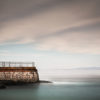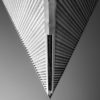
One could almost argue that digital photography is a different medium than traditional photography (film, wet plate, etc.), despite their fundamental similarities. Or at least it has the potential to be. It’s not that photo manipulation is unique to digital photography; manipulation has been practiced since long before digital imaging technology arrived on the scene. Master printers have been fooling people in the darkroom for decades. Anyone doubting this should take a quick look at the work of Jerry Uelsmann, for example. However, a passable photo manipulation in the digital realm is certainly now more accessible and, dare I say, easier to achieve than its analog counterpart.
In fine art photography circles I often hear debates about how much post processing is acceptable before you can no longer call a photograph a photograph. Part of me finds this argument ridiculous (I’m not much for labels anyway), and part of me is able to understand the feelings behind the subject. On the one hand I believe that art can be, and should be, created by any means necessary to achieve the vision of the artist (as long as the artist is honest about his methods). Art is subjective and each artist needs to decide for himself which lines he is willing or unwilling to cross. Nobody asks a painter, “Did it really look like that?” It simply isn’t relevant to the painting. Photojournalism aside, I don’t think the question is relevant to photography either. Obviously if you are a documentary photographer or a journalist, you must adhere to a code of ethics in your reporting. In the realm of art I see no need for such concern.
On the other hand I know the amount of time and practical experience it takes to master the craft of photography. I can empathize with skilled photographers irritated by the new wave of wannabe photographers who lack skill behind the camera but exploit the newest processing trends (for example, HDR or selective coloring) to give their images more impact and mask their shortcomings in the medium. It’s not that these techniques can’t be used to good effect, but they usually aren’t. Unfortunately, I do see many gimmicky, over-saturated, high-contrast images getting a lot of unwarranted attention on media websites despite poor composition and bad exposure. Subtlety and elegance seem to be lost on the general public in favor of gaudy, over-processed images that sucker punch the viewer in the face but ultimately, I believe, won’t stand the test of time.
As a photographer I use many tools to achieve my vision. After an image or idea is conceived and the necessary planning and problem solving steps are taken, I bring in the camera. In addition to the camera I may also employ a variety of peripherals such as selecting a specific lens, filter(s) for the lens, a remote timer, artificial light source(s), or light modifier(s). Once my exposure has been made I move into processing the RAW image with software. For some people there’s an immediate stigma attached to the words “Photoshop” or “post-processing.” The reality is that even film had to be developed. The way the film was developed, and the print made, is just as much a part of the artistic and creative process as composing, calculating, and making the exposure in the camera. So it is also with digital post processing.
The camera has many limitations and cannot see nearly as well as the human eye. A good photographer understands these limitations and can use them, even as strengths, to achieve their vision through the medium. The notion that a “true” photographer takes the images straight from the camera without alteration simply isn’t accurate. Photographers such as Ansel Adams and Richard Avedon, who are hailed as masters of their craft, were absolute wizards in the darkroom and heavily manipulated their photographs to achieve their vision.
I have my own lines that I’m not willing to cross. For example, I won’t typically add something that wasn’t really there in the scene, but I’ll take away things that I find to be a distraction to my vision. This may be as simple as zooming in or moving closer to “crop” out the distracting elements as I’m making the exposure or it may mean “photoshopping” them out in post production. Occasionally I will combine more than one exposure but this is one of those lines I don’t like to cross if I can avoid it. I don’t begrudge other photographers for doing it, I just prefer to capture my vision in a single exposure if possible.
The upside to the power of the digital darkroom, so to speak, is that it unlocks a wealth of potential for realizing an artist’s vision. The downside is that it has made many modern art viewers skeptical and untrusting. There have been several occasions where I made an image by being in the right place at the right time, “seeing” something uniquely, and using my camera skillfully, only to have “Photoshop!” hurled as an accusation by a suspicious viewer. The reason I find this sad is that the magic and wonder of our world is sometimes captured but lost on the viewer because they don’t think it is possible for that moment to have actually existed. They feel they are being tricked and their jaded perception keeps them from appreciating something special. Regardless of whether or not post-production tricks are employed, when we learn to appreciate what is in front of us as the unique artistic vision of the artist, rather than insisting on using our perception of reality as a measuring stick, we will see more beauty.
When people ask about my photographs, “Is that how it really looked?” I am not being dishonest when I say, “Yes.” That is how it looked, and felt, to me, in my mind’s eye. My vision is not limited to what the camera sees. I am an artist. My camera is just a tool, used to express my vision; to show you how I see things. This is my art. Just because my camera is able to create a factual record doesn’t obligate me to be a documentarian. I am an artist. By sharing my art I am saying, “Welcome to my world.”


